Introduction
John Grimek, known as the Monarch of Muscledom, was both a weightlifter and a bodybuilder. He competed in the 1936 Olympic Games, was crowned Mr. America twice in succession (1940/41), and won Mr. Universe in 1949. During his competitive years, Grimek was never beaten on the posing dais. He was the T-Rex of his era, and just about anybody who was fortunate enough to see this man in person was left in awe by his muscular development.
In addition to possessing huge muscles, Grimek was very intelligent and extremely knowledgeable about productive weight training. He was a writer for Strength and Health magazine, and for many years he was Bob Hoffman's right-hand man. (For those who don't know, Hoffman was founder and owner of the York Barbell Club, publisher of Strength and Health, and coach of the American Olympic Weightlifting Team between 1936 and 1968.)
Grimek was the master of muscle-building and once the World's Best Built Man. Even today, he remains one of the greatest drug-free bodybuilders who ever lived. Thus, wise would be the fellow who is looking to add inches to his chest to study and put into practice the information presented henceforth. Revealed in this article—in exquisite detail—are John Grimek's exact teachings and “secrets” for building a deeper rib-box and molding shapely pectorals. Many of the words are mine, but all of the concepts and all of the recommendations are straight from the champ's training notes.
Enjoy, learn, train hard, and prosper.
Main Feature
In Developing a Spacious Chest, Grimek emphasized that a great chest is built from the inside out, not just from developing the external muscles which envelop it. Large pectorals and sweeping “lats” alone will not give the chest the breadth and depth needed for overall impressiveness, development, and robust health. As Grimek pointed out, the key to acquiring these three desired qualities is the development of a spacious rib box through exercises which induce deep breathing.
Performing exercises which accelerate breathing will not only add “real” inches to your chest, but will also help to improve your health and well-being. Grimek explained that a voluminous chest will provide the lungs, heart, and other organs within the chest cavity the space needed for optimal efficiency, development, and function.
According to Grimek, deep breathing induced by muscular activity increases the size of the rib box by stretching and growing the flexible cartridge which joins the ribs to the sternum bone. Such deep breathing also allows the lungs to function at full capacity, revitalizes the blood by facilitating the removal of waste products, and revives worn tissue by substantially increasing oxygen supply.

To build the chest fundamentally, exercises must be done which cause a rapid, deepened, and sustained state of breathing. Additional exercises should also be performed which stretch the ribs up and out when the trainee is breathing rigorously. Grimek advised that leg exercises done with relatively light weights and a high number of repetitions are best for inducing a breathless condition. The two-time Mr. America explained,
“Quite a few years ago, at the time I first began to experiment with leg training to a greater extent than previously, I discovered that my leg muscles were not the only group that responded during this time, and was pleasantly surprised to see my chest grow and bodyweight increase. As I continued to employ various leg exercises, my chest grew from a snug 39 to 45 1/2 inches in less than a year.”
The York star wrote that after performing a set of high-repetition squats, he would gasp for air and take in short but rapid inhalations for a minute or two, after which his breathing would be slower but more profound. Grimek would then perform a chest expansion movement, such as the dumbbell pullover or the standing lateral raise. According to the champ, the effectiveness of a chest-expansion exercise is greatly increased by first performing a demanding leg exercise to induce a deep state of breathing.
A chest-expansion exercise works best if the arms are raised overhead while deeply inhaling. Grimek indicated that raising your arms overhead with each inhalation allows more air to be forced into the lungs and a greater lung pressure to develop. As lung pressure is increased, a greater pushing force is generated within the chest cavity, resulting in a greater stretch to the rib box.
Grimek used many variations of the pullover exercise to stretch his chest, including the bent-arm type. For a maximum stretch, he kept his hips low and off the bench. He also used a weight that was light enough to prevent excessive muscular contraction. If too heavy a weight is used, Grimek indicated that the expansion benefit of a chest-expansion exercise is compromised by excessive muscular strain.

In addition to performing a pullover movement after each set of breathing squats, Grimek would often stretch on a chinning bar with his arms held straight and overhead. He referred to this movement as “a great chest stretcher.” While hanging from the bar, Grimek would inhale rhythmically and force as much air into his lungs as he possibly could.
From time to time, Grimek also utilized overhead presses to encourage stretching of his rib box. Grimek explained that moving the arms overhead stimulate the serratus magnus muscles, the muscles which lie on each side of the ribs. These muscles help to raise and spread the ribs when brought into play, thus permitting a fuller stretch and deeper breathing.
For expanding the rib box, Grimek emphasized that heavy weights should not be used. In his own words,
“I found that those who failed to achieve success [with his recommended training program for chest expansion] didn't follow the program as originally outlined, but employed much heavier weights and cut down drastically on the repetitions, which provided the clue to their failure. In this case it was important, yes, very essential that the number of repetitions involved should cause them to gasp for air when finished, not merely breathing slightly heavier than normal. Once this was done, using twenty or more repetitions for the first set, with progressively less reps and increased weight with each succeeding set, the results were amazing.”
For best results, Grimek recommended that the following chest-expansion training routine be followed for several weeks at a time:
- Squat: one set 18 to 20 reps minimum; follow with a chest expansion exercise (dumbbell pullover, bent-arm pullover, etc.).
- Squat: one set 12 to 15 reps; follow with a chest expansion exercise.
- Squat: one set 8 to 10 reps; follow with a chest expansion exercise.
- Squat: one set 5 to 8 reps
- Squat: one set 3 to 5 reps
With each succeeding set of squats, the weight should be increased, but not to the point where proper breathing or exercise form is sacrificed. The first three sets of squats are performed to build endurance and to stimulate rib-box expansion. The final two sets of squats are done with a heavier weight and a lower number of repetitions to pack the legs with strength and muscle. Grimek did not declare an optimum training frequency, but one could expect excellent results by performing this specialization program two to three times per week.

During the 1940s and 1950s, many strategies were developed by bodybuilders across the world with the hope of making the breathing squat even more effective. One such strategy involved inhaling for a specific number of repetitions between each repetition. Although this technique was practiced and recommended by a number of strength authorities during the Golden Age of physical culture, Grimek did not believe this method of training was necessary to enlarge the rib box. He related,
“It's doubtful if special attention given to breathing will bring any better results for those who practice this style than those who breathe as the occasion demands. I have never observed any special breathing details, but breathed as nature dictated under the circumstances.”
Grimek was a big believer in diversification when it came to exercise. Variety, he said, rejuvenates a lifter's training program and stimulates new muscle growth. Without variety, he argued that a lifter becomes stale, loses enthusiasm, and fails to develop a fully balanced and symmetrical physique. It is for these reasons that Grimek practiced a relatively large number of chest and other exercises over his long training career.
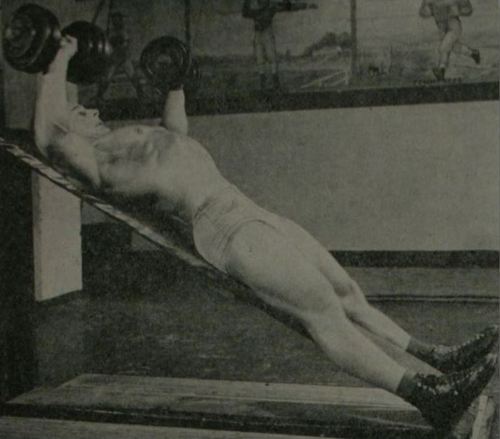
The commercialization of the incline bench in the early 1950's brought popularity to this apparatus, and it was described by many as a “new invention” for building muscles. This muscle-building device had its beginning far earlier than commonly believed, however. Grimek used a primitive form of the incline bench as far back as the early 1930's. It was at this time that the strongman discovered that performing chest exercises while in an incline position can greatly aid expansion of the rib box and development of the chest muscles. Describing the exercises he practiced on an incline bench, Grimek reflected,”
“These exercises will affect the muscles more vigorously and in a different manner. Because of their nature and the leverage involved they have the ability to stretch and pull certain muscle groups more completely thus activating them more thoroughly.”
Grimek held a similar viewpoint for decline bench work. He argued that many movements take on new life when done in a descending position. An example is the pullover. When done on a flat bench, the pectorals, deltoids, and upper back muscles are allowed to relax when the weight is brought up and over the face. However, when this movement is done on a decline bench, the angle of the weight relative to the body keeps tension on these muscles even when the weight is suspended overhead.
Grimek did not favor doing “bench” exercises in one particular plane over another. Rather, he opted to do a mix of supine, incline, and decline work. By using all three planes in his chest training (though, not necessarily in the same workout), Grimek believed that he developed his muscles more thoroughly and more broadly than he would have had he solely trained on a flat bench. Furthermore, Grimek often used a variety of different benches and incline/decline positions to ensure that his muscles developed uniformly. He urged lifters to experiment with different bench constructions and incline positions to determine which configurations were most conducive to their particular needs and exercise choices. Via Strength and Health, Grimek explained,
“It is best to have a bench that can be adjusted to any desired incline needed, or else have two or three benches of varying inclines. One may find that on certain inclines the two hands dumbell [sic] press is easier done although not less effective. While another angle of incline such leverage movements such as the pullover and similar exercises can be practiced more advantageously. Some benches vary in their construction from the floor to the seat, which has a slight advantage for some while it may handicap another. Therefore discover the angle you prefer to perform your exercises and stick to it. On the other hand it is wise, if you have the equipment and time, to use all variations of the inclines and perform a set of exercises on each.”
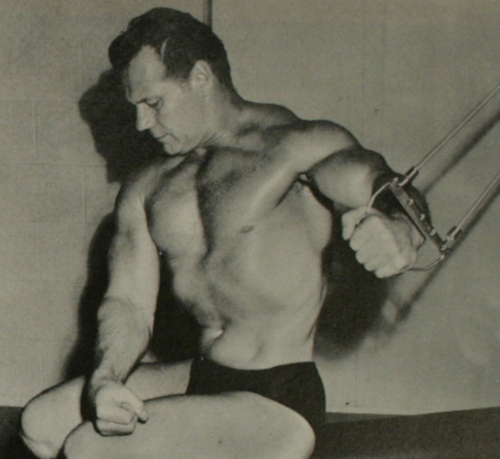
During his bulk-gaining years, Grimek typically employed six “bench” exercises for building his chest, although only a selected few of these were done during any particular workout. He would often recommend to a lifter seeking to build a bigger chest to include two or three exercises from this group in each workout, selecting a different combination of exercises and/or a different bench position (supine, incline, or decline) each training session. These six exercises are outlined below, each with performance tips as were dictated by the Big Man, himself.
(1) Press with Barbell – Whether done in the supine, incline, or decline position, Grimek considered this exercise to be a superb movement for developing the muscles of the chest, back, arms, and shoulders. He preferred to do this movement with a relatively wide grip, and he pressed the weight in a straight line upwards. Grimek generally recommended doing 12 to 15 repetitions each set.
(2) Bent-Arm Pullover – This exercise is done with either a barbell or a pair of dumbbells, and the arms are kept bent throughout the movement. Bending the arms allows a slightly heavier weight to be used without undue strain on the shoulders. As the weight is brought back and behind the head, the hips should remain low on the bench or seat, the back should be kept flat on the bench, and you should inhale as deeply as possible. After a full stretch, the weight is brought upwards and above the head as you exhale. Grimek generally recommended 15 to 20 repetitions each set.
(3) Stiff-Arm Pullover – This exercise is done just like the bent-arm style except the arms are kept straight throughout the movement. A lighter weight is employed, and extra focus is placed on deep breathing and stretching of the rib box. Again, Grimek generally recommended doing 15 to 20 repetitions per set.
(4) Dislocation or Semi-Inverted Lateral Raises – John Grimek called this movement “a great latissimus dorsi muscle builder.” The dislocation exercise not only builds all the muscles of the upper back, it is useful for building the shoulders, the pectorals, and for expanding the rib box. Grimek described how to perform this movement as follows,
“Select a pair of dumbells [sic] which can be handled fairly easily to prevent any shoulder injury. Start movement from thighs and allow arms to swing down [a decline bench is assumed here], by muscular action of course, and meet overhead. Keep arms moving in line with body from overhead. When correctly executed this exercise will bring about phenomenal development in the entire torso, particularly the great latissimus dorsi. Breathe deeply as weights are carried overhead. Exhale as they are returned to starting position on thighs. 12 to 15 repetitions are necessary.”
(5) Press with Dumbbells – For best results, Grimek recommended that the arms be held away from the body and the elbows be pointed sideways. Using this technique, he pointed out that the pectorals are more strongly stretched and stimulated. Use a weight that will allow for 12 to 15 repetitions in perfect style.
(6) Lateral Raise (today, often called “dumbbell flyes”) — This was a very popular exercise for building the chest in years past, and it was one of Grimek's favorites. He typically performed this movement while keeping his arms straight. However, he sometimes employed a slightly heavier weight and performed this exercise with bent arms. Each style, according to Grimek, affects the chest muscles and pull on the rib box slightly differently, and the bodybuilding star recommended that both versions be done from time to time for best results. If, however, the straight-arm version causes shoulder pain, Grimek advised doing only the bent-arm version. Regardless of style performed, however, he emphasized to inhale deeply as the arms are extended (dumbbells moved towards the floor), and exhale as the weight is raised and crossed over the chest. Grimek recommended doing 15 to 18 counts per set of this exercise.
Grimek cautioned that a lifter should master the correct form of the six exercises described above before concerning himself with using heavy weights. Only after you can easily perform the upper number of repetitions in good style should you increase the weight used for a particular exercise. Grimek urged this practice because deep breathing, as required for chest expansion, is hampered if too much weight is used. Additionally, Grimek recommended this practice to help prevent shoulder injuries.



Although John Grimek trained with a variety of bench angles to enlarge his chest, he was particularly fond of decline-bench exercises because he believed the descending position has a healthful effect upon the body. He elaborated,
“The decline attitude is very beneficial to the body in general. During the entire day we either stand or sit and gravity naturally exerts its downward force on our organs. In this new position the organs are gently pushed back into their place and [this] relieves the strain from our upright position. Blood circulation is increased in this position without any added strain on the heart... Even the brain receives new and larger quantities of blood, clearing the ‘cobwebs’ for more efficient thinking. Yes, this exercising attitude has some unusual merits, but if you entertain any doubts, try it yourself and you be the judge.”
To perform chest exercises decline style, Grimek recommended using a sturdy abdominal board, or any other board which is sturdy enough to support a combination of your body mass and the exercise weight. Grimek “hooked” his feet in place by using the straps on his board. Without such straps, another means must be found to keep the feet steadily held. Grimek suggested that one option is to secure yourself by the crook of your knees, by dropping your lower legs over the edge of the high-end portion of the incline board.
Grimek also advised that the bottom edge of the incline board be elevated before practicing stretch exercises, such as the lateral raise or the pullover. This can be done by resting the board on a sturdy box or bench. Doing this will prevent the dumbbells or barbell from contacting the floor before a full stretch can be obtained. With the exception of a few exercises, such as the partial bench movement described below, Grimek favored attaining a complete stretch, as he believed doing so aids muscular development.
The former Mr. America was often asked if the shape of the pectorals can be changed. He explained that only the contour of a muscle can be altered, not the basic shape. In the October 1960 issue of Strength and Health, Grimek indicated,
“. . . if you expect to find a way to shorten or lengthen the muscles structure itself, let me save you some time and trouble and tell you this is impossible. All muscles have a point of origin and a point of termination. Between these points, it's possible to develop them to almost any size, but nothing will increase or shorten this distance. This is true of all muscles, and this is what governs and gives shape to muscles, not size.”
Although the basic shape of a muscle is governed by heredity, Grimek pointed out that a targeted region of the pectorals can be emphasized and developed by selecting the right exercise. For example, many bodybuilders desire to acquire a sharper outline of the pectorals, especially at the bottom and outer edges. Grimek stated that various chest exercises, particularly presses, pullovers, and bent-arm lateral raises, are useful to meet this goal, especially when done in the decline position. This orientation, the strongman indicated, helps to stimulate the section along the bottom of the pectorals by increasing the stretch at this area.
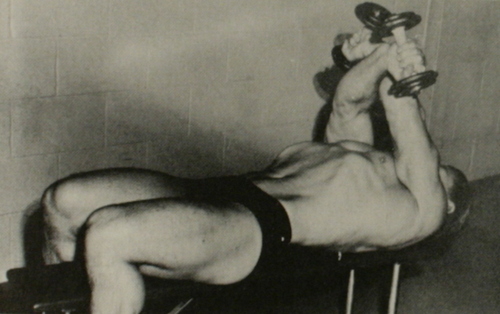
Grimek also emphasized that the “flying” exercise can be made more beneficial to the inner pectorals by moving the arms past the sideways position and continuing until they are crossed over the chest. Crossing the arms at the top portion of this exercise, Grimek found, greatly increases contraction of the pectorals and helps to bring forth better muscularity and a sharper outline of these muscles. Grimek also found that the inner section of the pectorals can be highly stimulated by squeezing the two handles of a crusher apparatus together or by bringing the arms across the chest with resistance from a wall pulley or cable.
Although he favored strong and shapely chest muscles, Grimek cautioned readers of Strength and Health against growing the pectorals too large. He wrote,
“I am not suggesting that these muscles be ignored... they shouldn't be. But neither should they be developed beyond other proportions and infringe upon the body's symmetry. Body symmetry is more important and is the sole factor by which one physique is more outstanding than another—never over-development of some muscle group.”
The strongman also warned that overdeveloped pectorals may begin to sag and acquire a flabby look, especially as the lifter approaches middle age and/or if he fails to train regularly.
Grimek indicated the vast majority of bodybuilders can keep their pectorals firm by training them regularly and by not going bulk crazy. However, he warned that an unfortunate few lifters may naturally have flabby pectorals due to a condition called gynecomastia. If a lifter suffers from this condition, exercise alone will not eliminate the flabbiness of his pectorals. Rather, Grimek stated that hormone (testosterone) injections under the direction of a medical doctor, along with exercise, may be necessary before the bodybuilder who suffers from gynecomastia can overcome it and establish a firm set of pecs.
Although John Grimek rarely practiced the bench press, he did believe that this exercise has “meritorious value in developing muscles,” but only if this lift is employed as part of a general plan to build a symmetrical physique. Reflecting on this belief, he stated in Strength and Health,
“Too often this exercise is overdone with one goal in mind: to acquire large and massive pectorals. If this is your aim, then you're wasting your time and energy. Not that this exercise wouldn't develop the pectoral muscles... it would. Almost too much so. Your aim should be to strive for all-round symmetry and not for one particular muscle.”
For strength athletes who prefer to practice the bench press, Grimek stressed four rules to ensure safe execution of this exercise and to ensure that this movement stimulates all the muscles of the upper body, not just the pectorals. These were:
- Rule 1: Use a weight which you can comfortably handle for the desired number of repetitions.
- Rule 2: Avoid violent starts, arching of the back, raising the hips off the bench, and digging the heels into the floor.
- Rule 3: Do any number of repetitions that you find desirable or beneficial. Grimek believed that the best rep scheme depends upon the individual and must be determined by experiment.
- Rule 4: Use a grip spacing which feels most natural. Experiment with different spacing to determine which grip width is best suited for you. Some bodybuilders, Grimek explained, do best with a very wide grip (collar to collar); other lifters favor a relatively narrow grip (about shoulder width apart). The majority of lifters, the muscular fellow indicated, do best with a grip somewhere between these two extremes.
While the bench press is most often performed with a barbell, Grimek also recommended that doing this exercise with a pair of dumbbells may be better. He pointed out that dumbbells allow for free and natural movement of both arms, unlike the barbell, which essentially locks the hand spacing.
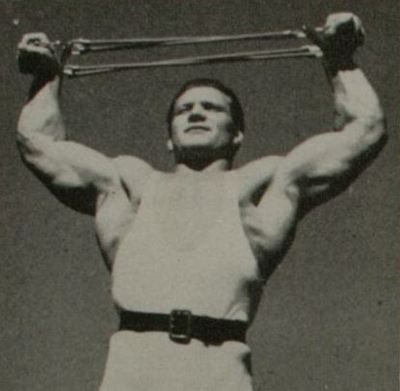
Although Grimek did not favor the bench press, the strongman indicated that when he was a young lifter he practiced this lift often in floor-press form. He once did a floor press with around 375 pounds. This was done in very strict style, and at the time the world record in this lift was 382 pounds and held by Joe Nordquest.
Grimek was proud of his press form, but he grew alarmed as the bench press gained popularity and he observed that many lifters were sacrificing good exercise style in favor of more weight. Grimek expressed his frustration in the January 1957 issue of Strength and Health by saying, “Watching fellows do this lift [the bench press] today makes you wonder whether they're trying to lift the weight or keep the weight from crushing them!”
During his younger years, Grimek sometimes employed partial reps on the bench press, and doing so proved to be an excellent strength builder. Using a weight that was about 20 to 25% higher than normal, he would lower the barbell only about two to four inches from the fully-extended position and then push the weight back. A typical bench-press session of this type would involve five to eight total work sets, each consisting of five or six partial reps. Grimek would also increase the exercise weight with each succeeding set.
The biggest star at York Barbell believed that the body responds best when trained as a whole, and he typically trained three times per week. A whole-body training regimen that the famous bodybuilder often turned to for gaining muscular bulk was featured in the September, 1952 issue of Strength and Health. This training program, which is outlined below for reference, was also recommended by Grimek to strength athletes at all levels of development to stimulate muscular growth. The more advanced fellow may want to add a few exercises, increase the number of sets per exercise and/or alter the selection of exercises to meet his needs. However, Grimek explicitly warned that a lifter add additional work to this routine only if he could still feel “refreshed” after a workout.
| Exercise | Sets and Reps |
|---|---|
| Warm-up - high deadlift, fast | 1 X 8-10 |
| 2 hands curl | 1-2 X 8-10 |
| 2 hands reverse curl | 1-2 X 8-10 |
| Bent over curl, single arm | 2-3 X 7-8 |
| Press behind neck, sitting | 1-2 X 8-10 |
| "French curl", barbell | 1-2 X 8-10 |
| Squats, fairly light weight | 1 X 15-18 |
| Pullover on bench | 1 X 12-15 |
| Squats, increase weight 20 lbs | 1 X 12-15 |
| Lying lateral raise | 1 X 12-15 |
| Squats, increase weight 15 lbs | 1 X 8-10 |
| Pullover on bench | 1 X 10-12 |
| Squats, increase weight 10 lbs | 1 X 6-8 |
| Lying lateral raise | 1 X 10-12 |
| Squats, increase weight 5 lbs | 1 X 3-5 |
| Two hands press | 2 X 8-10 |
| Rowing exercise | 2 X 8-10 |
| Shoulder shrugs | 2 X 10-12 |
| Deadlift | 2 X 10-12 |
| Straddle lift | 1 X 10-12 |
Elaborating further on his suggested mass-building routine, Grimek advised,
“... after following the above program for a month or so, vary it by making the following changes: Assuming your training days are Mondays, Wednesdays, and Fridays, follow the foregoing program on Mondays and Fridays, but on Wednesday handle much heavier weights, 15 to 30% more in each exercise, and cut down on the reps. Instead of doing five sets of squats, use three. You'll find this added resistance will work the muscles harder and jar them from their usual routine. Also, in this way you will discover which scheme of repetitions your muscles respond to best; heavier poundages and less reps, or lighter weights and more reps.”
Grimek's prescribed training program for building muscular bulk shows how the famous bodybuilder incorporated the principles of chest training discussed in this article into a whole-body muscle-building plan. Note how he merged breathing squats and rib-box stretchers with various compound exercises. Thus, implementation of this workout routine, as directed above, not only could help you add inches to your chest girth, it could help you gain many pounds of muscle over your entire body.

In conclusion, John Grimek believed that the key for building a great chest is to first build a large and deep rib box, and then fully build the surrounding muscles with a variety of exercises. Building from the inside out will give your chest depth and an appearance which could never be achieved by training the external muscles alone. Grimek also believed that regular performance of exercises which induce deep breathing can do much to enhance one's health, energy, and well-being.
References
- Hoffman, Bob, The Big Chest Book, Strength and Health Publishing Co, 1941
- Grimek, J.C., Advanced Chest Exercises, Strength and Health, May, 1948
- Grimek, J.C., More Advanced Chest Exercises, Strength and Health, June-July, 1948
- Grimek, J.C., A Bodybuilder's Training Program, Strength and Health, September, 1952
- Grimek, J.C., Developing a Spacious Chest, Strength and Health, January, 1957
- Grimek, J.C., Your Training Problems, Strength and Health, January, 1957
- Grimek, J.C., Developing the Chest II, Strength and Health, February, 1957
- Grimek, J.C., Developing the Back, Strength and Health, May, 1957
- Grimek, J.C., Your Training Problems, Strength and Health, July, 1959
- Grimek, J.C., Know Your Basic Pectoral Shape, Strength and Health, October, 1960
- Grimek, J.C., That Controversial Bench Press, Strength and Health, November, 1960
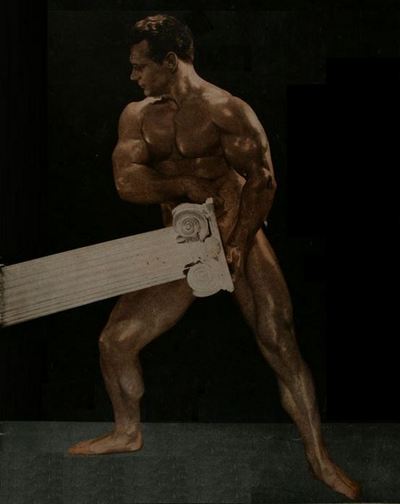
Add Comment